Marc Fischer
By Friday, March 13, 2020 I felt the full importance of staying home to slow the spread of Coronavirus, and I began to shelter in place in Chicago. Aside from trips for groceries, medication, and the post office, I don’t leave the house much. My wife, an academic advisor, is also working remotely. We have enough space that we aren’t on top of each other all the time. We can also be outside on our deck or in our garden. We are extremely lucky.
Many of the things I wanted to do creatively and am employed to do, either became impossible or had to be done remotely from home. Teaching moved online or stopped. Book fairs and zine fests were canceled. Two publishing projects had to go on pause. I needed to create another way to work.
I have made books and booklets and zines for over thirty years, and I felt that making another publication should be my immediate response to the crisis. The name Quaranzine came to mind, which is an idea that many other publishing minds surely had simultaneously. I’m against competition. We can all call our thing a Quaranzine. Sometimes the best title is the best title and now it feels like a movement. I just knew I wanted to make something and collaborate with others too. Everyone was about to go real stir crazy real fast, but not everyone has the means to print something at home. So on March 15th I published the first issue of Quaranzine under my Public Collectors imprint.
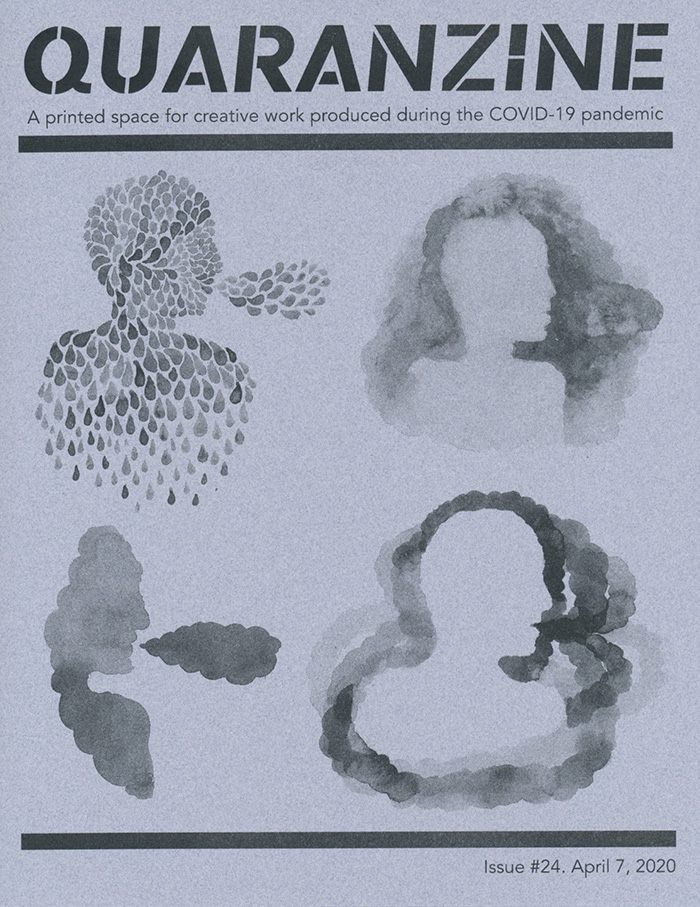
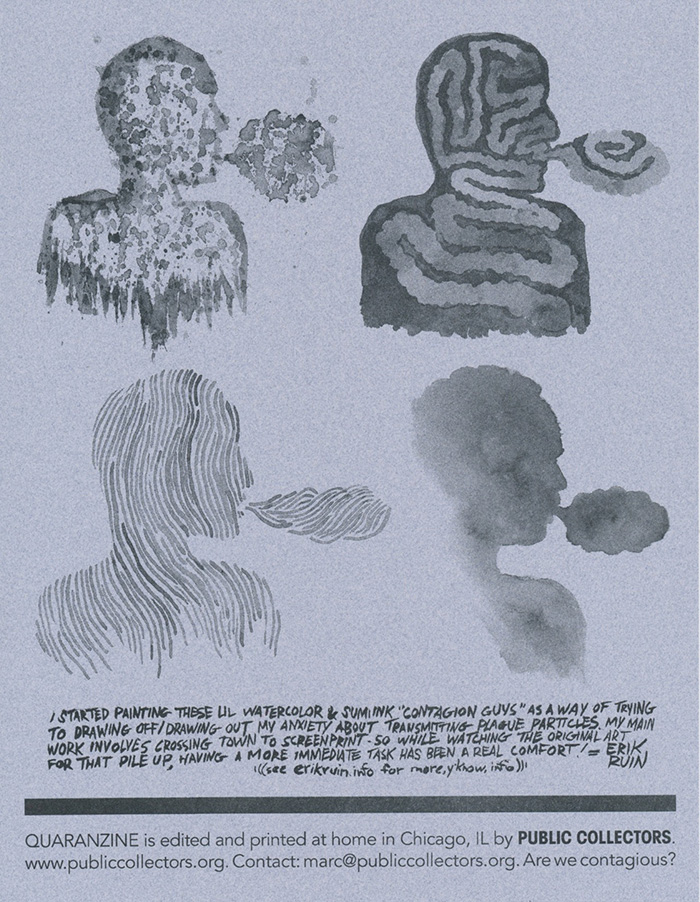
Quaranzine has all of the ingredients found in a complete publication. There is a title, issue number, date, crediting, and a thematic focus fulfilled through both sides of a single sheet of paper. I wanted to make things fast and I did not want to reinvent the design wheel every day, so I settled on some fonts, came up with a masthead, and created a basic template for each issue. I put the call out to others, deferred to their choices in typography when they had their own favorites, and just tried to keep it all moving so that I wouldn’t have as much time to be anxious about the virus.
I’m a member of the group Temporary Services, along with my collaborator Brett Bloom, and we have two Risograph duplicators. One of them lives in my basement, and I print a lot of publications with it. Usually I like a staple-bound booklet best, but the labor of collating, stapling, and folding is my least favorite part of publishing. I wanted to avoid that. I also felt like a single, unfolded double-sided sheet might be enough anyway. I love the idea of one-page zines.
Some days I didn’t make a publication, so the next day I made two. Sometimes I spent all day picking at an idea or the design. Other days someone else provided the content and I’d quickly throw it together and print it in a couple hours, then go take a nap.

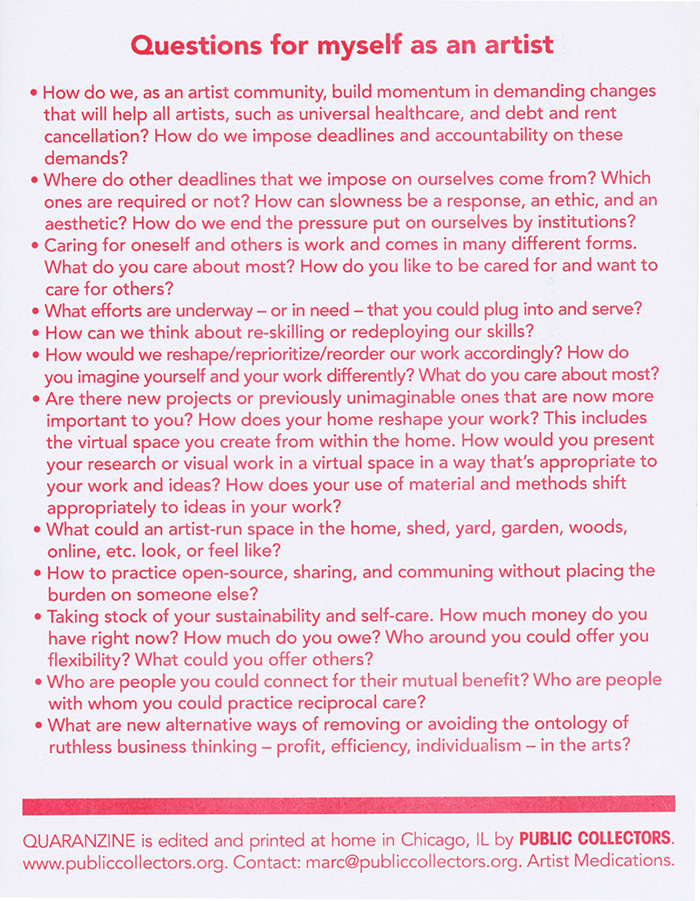
The range of Quaranzine themes was broad, and it expanded every day. For the first issue, I made photos of the worms in my compost pile in the backyard, and described their blissful ignorance of the virus. It did nothing to stop them from eating our banana peels and coffee grounds. The second issue was written by Laura Stempel, who courageously described the vulnerability she feels living alone with depression during the pandemic. Issue Three reprinted a forty-year-old poem from the journal CoEvolution Quarterly, written by a Peace Corps nurse describing the duties involved with handling the dead and relaying news to the family. For Issue Four, Dmitry Samarov drew and wrote about his days working for Lifeline—a company that made a medical alert panic button—and his experiences going to the homes of elderly people who pressed the button entirely because they were lonely and wanted someone to visit. In Issue Five, Michigan artist Nick Tobier drew his version of a display case behind glass in a gas station shop, and wrote a story about how the owner continually develops creative new ways of organizing all the merchandise as if it’s an art project. I wrote about the postcards that people who communicated on CB Radio made in the 1970s, and how Citizens Band Radio aficionados were masters of social distancing. My dear friend Doro Böhme died on March 20th, and that next day I wrote a tribute issue about her photographs, while also including the painful note that there cannot be a memorial or service at this time because of the virus.
A lot of other publishers and zine makers have been doing similar things, but some are only available as PDFs for download. I like online viewing—and it works well for a thing that’s just two sides of a page—but for me, the zine had to be printed. That’s what makes it real and solid and confirms every design decision. I started by working with ink and paper I already had on hand, and the printing reveals the limitations of my selections. I printed 100-175 copies of each issue based on how much paper I had or how much I liked a particular contribution. Later, I started selling assortment packs of 12 different issues, and the project became economically sustainable and turned into a part-time job. The project helped inspire Public Media Institute in Chicago to create another project, Quarantine Times and they hired me to be a special editor. Then that also became my work. Portions of this text were written for that project.
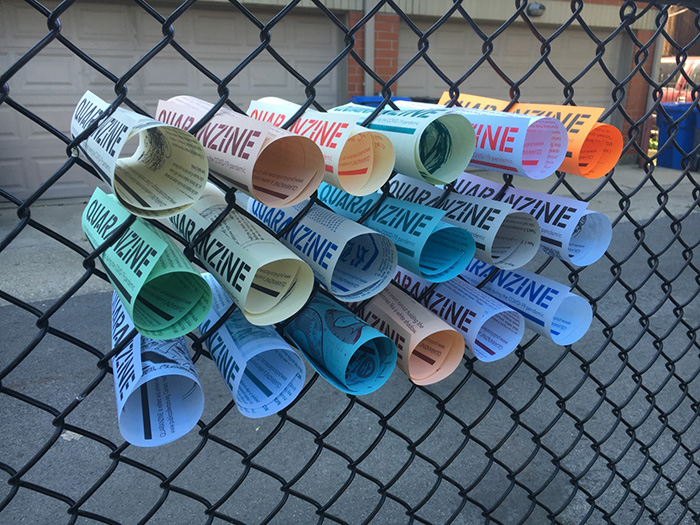
In addition to posting finished issues on social media, some copies of Quaranzine were shared in open air—not by getting together with people, but by taping the zines to bus benches, street poles, and dumpsters or sticking rolled copies through the holes in a chain link fence. Scanned versions of every finished issue, as well as documentation of public postings can be read here: https://publiccollectors.tumblr.com/tagged/QUARANZINE
Way back in issue #50 (which feels like it could have been last week, or a year ago, but was actually May 3rd), I wrote some reflections:
A lot is being written about the changes people are having to make in the way they live because of the pandemic—like when you go to the doctor and they see the poor choices you’ve been making and tell you sternly, “You’re going to have to make some serious changes.” For me this project is a reinforcement of processes and practices that have always been sustainable. I’m still self-publishing like I’ve done for over thirty years; it’s just back to basics. I’m still collaborating with others—including people I’ve never met in person that send me their work. I’m still making a big project by building gradually over time rather than consuming massive resources to make something large from the start. Quaranzine is intimate. It is not a spectacle. It is cheap to make and for others to support. It’s inclusive.
Collaborating, even during social distancing, means spending time with other people. Every day I spend a few hours emailing, designing, printing, and working in a way that shares time, thought, and emotion with others. We email back and forth until we like the way the issue looks and it’s time to print it on the Risograph in my basement. Once the issue is printed, I scan it and share the results and we get to celebrate that we made something together. Other people join the conversation online and discuss what we made.
Now is a time when a lot of artists are being forced to scale down in order to keep making things. They are playing concerts by themselves in their bedrooms and kitchens and broadcasting them over the internet. They are printing with tools like the inkjet or laser printer on their desk. They are making small drawings and sculptures and taking photos and writing. People aren’t consuming as much. They are looking at what they already have and saying, “I could make something edible with that weird ass combination of things in the pantry.” They are seeking knowledge from others, reading, and learning new skills. People I know that have never grown anything before are starting food gardens in their windowsills. People are also being gentle with themselves and taking it slow, which is a good idea.
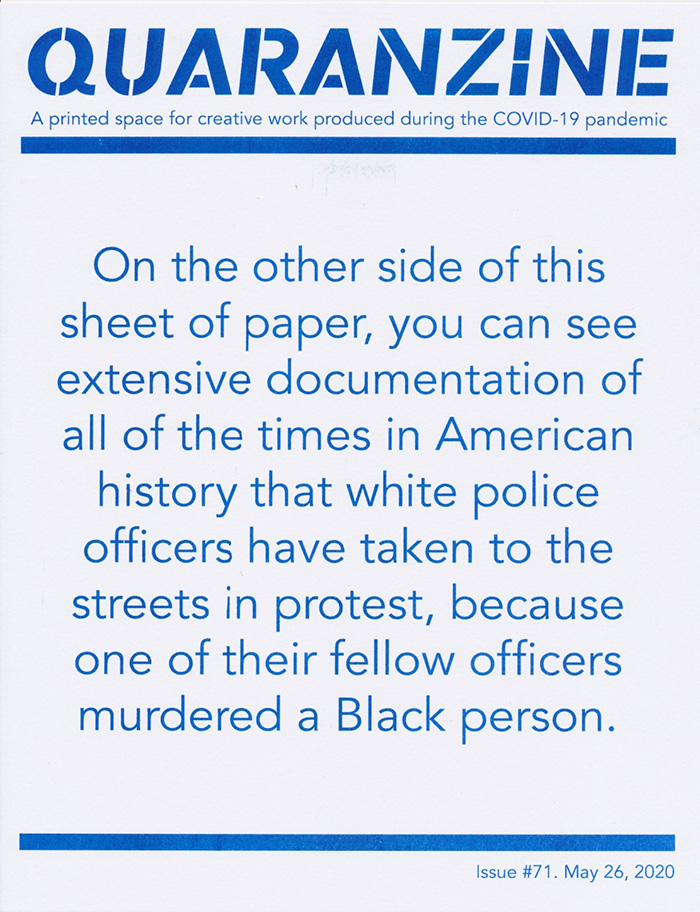

The murder of George Floyd by Minneapolis police and the subsequent protests all over the world forced a massive shift in where many people were focusing their energy; it was natural that this project should flex in that moment too. In the days the followed, drawings of masks and rants about grocery shopping experiences in Quarazine felt a lot less necessary. Some Quaranzine artists changed the direction of their contributions. Unexpected collaborations happened as people who may not have needed to vent about the virus, had a great deal to say about their experiences of racism and police intimidation. A musician friend from high school, Shawn Cephas—normally one of the most chill people I know—wrote a scathing letter to White amerikkka. Alexander Richard Wilson, who originally submitted drawings for consideration, instead allowed his written account of the May 30th protests in downtown Chicago to be the focus of his issue. Other people did what they might have done on any other day of the pandemic and that was okay too. We have many extremely challenging things happening simultaneously.
Quaranzine rushed into action quickly and created space for dozens of voices. People should understand, however, how extremely informal the project was. I’ve sent no contracts to be signed. Boring bureaucratic formalities don’t drive this kind of work; love and trust and shared values and creative commitments are what sets projects like this into motion.
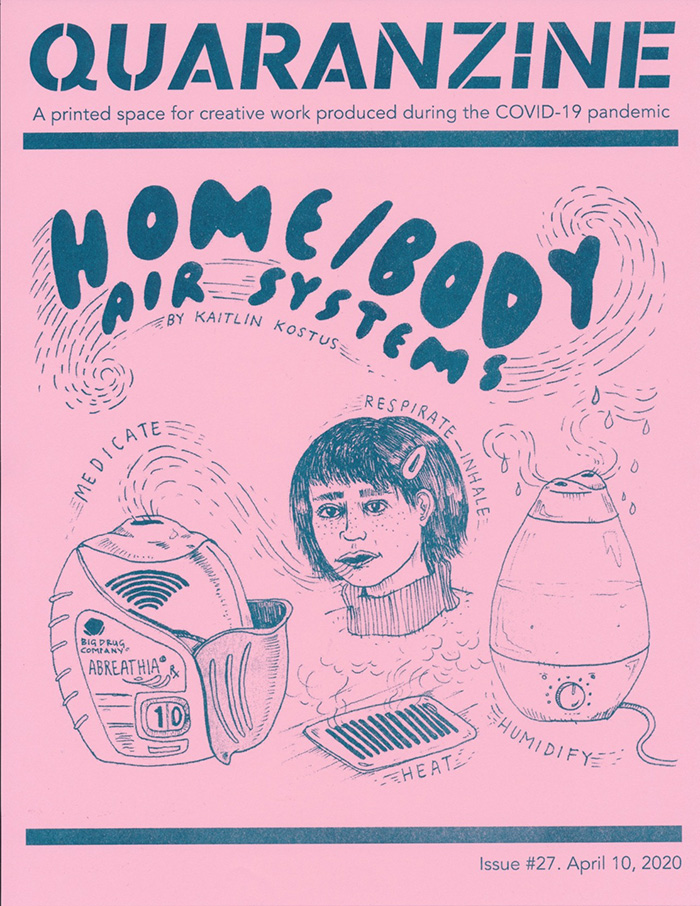
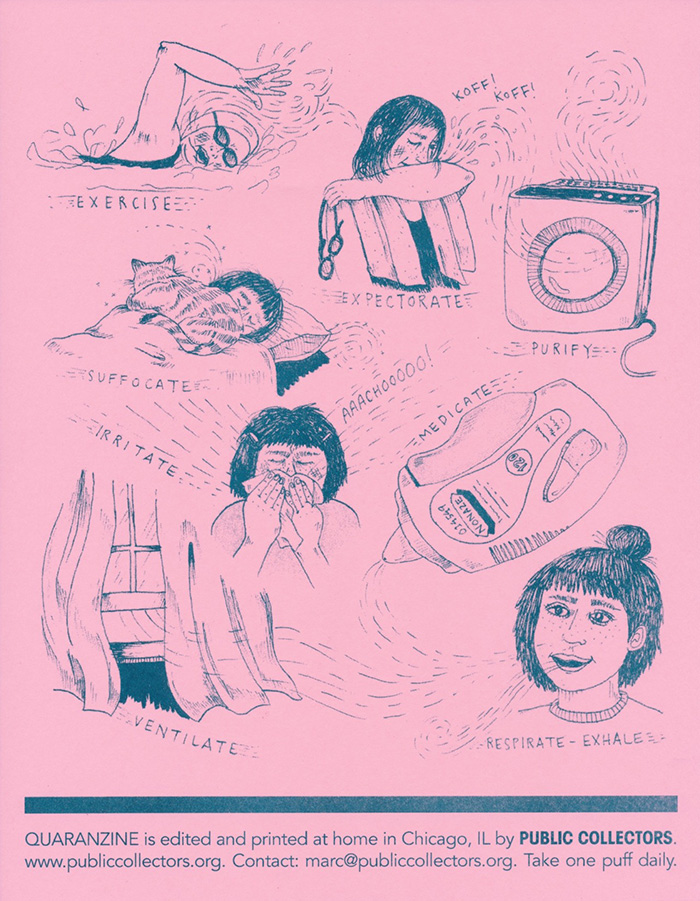
Quaranzine was a forceful reminder of what we have, and the potential for what we can do with these resources. At the very least, we have each other, and all we have to do is make time to see what we can produce together. Every person in your life is a potential collaborator if you create a structure that makes space for their knowledge and experiences. If we have trust, confidence in other people, and a belief that we can start and finish things together under atrocious conditions, people will do the best work that they can and we’ll make great things. And when it doesn’t work because someone just couldn’t, or I couldn’t when I thought I could, it has been important to go easy on ourselves.
Quaranzine was an exhilarating way to work but it not easy to sustain. I decided to stop at issue number 100. I had reached my goal of making 100 zines in 100 days (just between you and me, I made three zines on the last day to catch up because I was behind schedule).
In a collaboration, everyone has a stake in the thing that is being made so there is a place for feedback and editing and suggestions and alterations, and a selection process. Moving through that process so quickly when it’s not how you are used to creating is a little intense at times, but it worked astonishingly well in this project.
I don’t know if I will restart Quaranzine at some point, or if I will do something like it again. 100 issues in 100 days was not how I thought I would spend the first hundred days of my pandemic. Now summer is here and instead of catching my breath, I’m rushing to do other things that I wasn’t working on three months ago. I do know that if I decide to pick up Quaranzine again, it will just feel like a little stroll around the neighborhood rather than a marathon, and I hope my community will be there again to take that walk with me.
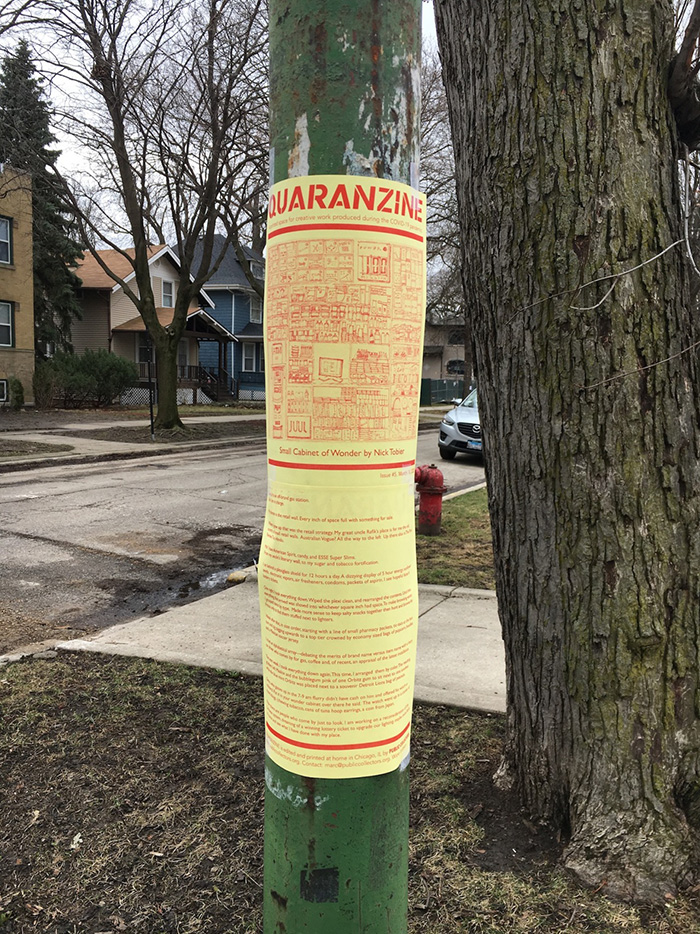
Marc Fischer is the administrator of Public Collectors, an initiative formed in 2007, which aims to encourage greater access and scholarship for marginal cultural materials, particularly those that museums ignore. Public Collectors’ work includes the Library Excavations publication series and web project, the Tumblr blog and publication series Hardcore Architecture about underground music in America, and Malachi Ritscher—a project about the late Chicago documentarian and activist, produced for the 2014 Whitney Biennial. In 2019 Public Collectors initiated the Courtroom Artist Residency, in which Fischer brings artists to observe Criminal Court in Chicago. The conversations that happen after court, along with additional writings, have been turned into a publication series: The Courtroom Artist Residency Report. Fischer is also a member of the group Temporary Services and a partner in its publishing imprint Half Letter Press Temporary Services and Half Letter Press have produced over 125 publications and Fischer has created over 45 publications under the Public Collectors imprint. He is based in Chicago.